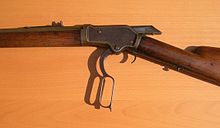Colt-Burgess Rifle
| Colt-Burgess Rifle | |
|---|---|

|
|
| general information | |
| Civil name: | Colt-Burgess Rifle |
| Developer / Manufacturer: | Andrew Burgess, Colt's |
| Development year: | from 1880 |
| Manufacturer country: | United States |
| Production time: | 1883 to January 1885 |
| Model variants: | Rifle, carbine |
| Weapon Category: | Repeating rifle |
| Technical specifications | |
| Caliber : | .44-40 WCF |
| Possible magazine fillings : | 15 (carbine 12) cartridges |
| Ammunition supply : | Tubular magazine |
| Fire types: | Single fire |
| Closure : | Knee joint closure |
| Charging principle: | Lever action rifle |
| Lists on the subject | |
The Colt-Burgess lever action rifle is a repeater rifle for .44-40 WCF center fire cartridges developed by Andrew Burgess from 1880 for Colt and patented several times . It was manufactured only briefly, from the spring of 1883 to January 1885, by Colt's Patent Firearms Manufacturing Co. of Hartford, Connecticut.
Technology & description
The Colt-Burgess rifle is a lever action rifle for black powder cartridges in caliber .44-40 WCF. Its external hammer is automatically cocked when reloading, the weapon is ready to fire. The tap can be lowered onto a safety catch to secure it. The lock is locked using a knee joint, the lower component of which is attached directly to the loading lever and which is directly connected to the lock by the upper component. The magazine located under the barrel holds 15 cartridges for the rifle, the carbine has 12 cartridges. As with the Winchester rifle, the refill opening is on the right-hand side of the breech block, but to open it is not folded in, but pushed forward.
Use, history
The weapon was planned to compete with the successful Winchester Model 73 in .44-40 caliber. The reason for the success of these weapons, which were successful in the Wild West, was the possibility of using the .44-40 as a unit cartridge for revolvers and rifles.
The reason the gun was only available in small numbers was as follows: Towards the end of 1884 a representative from the Winchester Repeating Arms Company came to Colt and told Colt's then chairman that Winchester was also interested in the revolver market, and he showed it Prototype of the planned Winchester revolver. The advance led to the following gentlemen's agreement . Colt declared that it would no longer manufacture lever action rifles in the future, and Winchester decided not to manufacture revolvers industrially in the future. Colt then stopped manufacturing the Colt-Burgess lever action rifles, a total of only 6403 of these weapons were delivered. It is interesting that Colt launched the Lightning Magazine Slide Action Rifle , a fore-end repeater (pump action) in the same .44-40 caliber as early as 1884 , for which the agreement did not apply.
variants
Colt-Burgess rifle
The rifle was offered with a round ($ 25.00) or an octagonal ($ 27.00) barrel with a length of 25½ inches, the additional price for longer barrels and magazines was $ 1.- per inch. The bolt, loading lever and hammer were color-hardened, the barrel and magazine were burnished. Few weapons were nickel-plated.
Colt-Burgess carbine
The carabiner was produced in the same caliber in a heavier and a lighter version (Baby Carbine), all of which had a carabiner ring attached to the lock housing on the rear left. The carabiners had a round 20 inch barrel, and they were also nickel-plated on request.
literature
- The Book of Colt Firearms , Sutherland & Wilson, 1971
- Colt and its Collectors , The Colts Collectors Association, 2003, ISBN 0-9652942-9-3
- Norm Flayderman: Flaydermans Guide To American Firearms , Krause, Iola 2001, ISBN 0-87349-313-3

